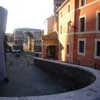Roman architecture, Rome historic buildings architects, Italy arches, Italian ancient churches photos
Roman Architecture : Historic Buildings in Rome
Traditional architectural designs in Rome and around the Mediterranean. Historic Italian capital structures.
post updated 7 June 2025
We select the key examples of Roman Architecture. e-architect try to include ancient architectural projects that are either of top quality or interesting, or ideally both.
These historic buildings and structures are all in Rome, Italy. We hope to bring further examples of Roman architecture from outwith this Italian city soon.
Roman Buildings
Key Rome Buildings, alphabetical – all photos © Adrian Welch:
The Pantheon
Dates built: 118-128AD
Built for Hadrian
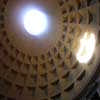
The building is cylindrical with a portico of large granite Corinthian columns (eight in the first rank and two groups of four behind) under a pediment. A rectangular vestibule links the porch to the rotunda, which is under a coffered concrete dome, with a central opening (oculus) to the sky. Almost two thousand years after it was built, the Pantheon’s dome is still the world’s largest unreinforced concrete dome. The height to the oculus and the diameter of the interior circle are the same, 43 metres (142 ft).
Colosseo – Colosseum, Campitelli

The Colosseum is built of travertine limestone, tuff (volcanic rock), and brick-faced concrete. The Colosseum could hold an estimated 50,000 to 80,000 spectators at various points of its history over the centuries.
It was used for gladiatorial contests and public spectacles such as mock sea battles, animal hunts, executions, re-enactments of famous battles, and dramas based on Roman mythology. The building ceased to be used for entertainment in the early medieval era. It was later reused for such purposes as housing, workshops, quarters for a religious order, a fortress, a quarry, and a Christian shrine.
Forum Romanum – Roman Forum

Castel S.Angelo – Hadrian’s Mausoleum

Arco di Constantino – Constantine’s Arch

Santa Maria in Cosmedin, south Rome

Santa Pudenziana
one of the oldest churches in Rome, southwest of Santa Maria Maggiore

Teatro di Marcello – Marcellus’ Theatre

Terme di Carcalla – Baths of Caracalla
+++
Key Roman Public Spaces
Area Sacra, Largo Argentina, Corso Vittorio Emanuele II
ancient roman remains, various centuries

Campo de’ Fiori
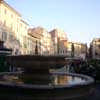
Campo de’ Fiori is a rectangular square south of Piazza Navona, at the border between rione Parione and rione Regola. It is diagonally southeast of the Palazzo della Cancelleria and one block northeast of the Palazzo Farnese.
Campo de’ Fiori, translated literally from Italian, means “field of flowers”. The name dates to the Middle Ages when the area was a meadow.
Circo Massimo – Circus Maximus, southeast Rome

The Circus Maximus is an ancient Roman chariot-racing stadium and mass entertainment venue. In the valley between the Aventine and Palatine hills, it was the first and largest stadium in ancient Rome and its later Empire.
It measured 621 m (2,037 ft) in length and 118 m (387 ft) in width and could accommodate over 150,000 spectators. In its fully developed form, it became the model for circuses throughout the Roman Empire. The site is now a public park.
Fontane di Trevi – Trevi Fountain

Forum Traiano – Trajan’s Forum
Piazza Colonna, Via del Corso
Column erected 2nd C AD – honours Marcus Aurelius

Piazza della Rotunda – facing The Pantheon
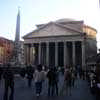
Piazza del Campidoglio, Monte Capitolino
Piazza del Popolo
plan, with twin churches to south: Carlo Rainaldi

Piazza di Quirinale, northeast Rome

Piazza di Montecitorio
Obelisk
Date: 6th C BC, erected 1792
Piazza di Spagna
Piazza Navona – ancient circuit transformed in Baroque era

More Roman Buildings online soon.
Location: Rome, Italy, southern Europe
Famous Roman Structure, no image
Trajan’s Column – Colonna Traiana, Trajan’s Forum
Project beside Roman Building
Carré d’Art, Nimes, France
Date built: 1993
Design: Foster + Partners
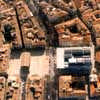
Nigel Young, Foster & Partners
Carre d’Art Nimes
The Carré d’Art shows how a building project, backed by an enlightened political initiative, can not only encourage a dialogue between ancient and modern architectures but can also provide a powerful catalyst for reinvigorating the social and physical fabric of a city. The challenge was to relate the new to the old, but at the same time to create a building that represented its own age with integrity. The site faces the Maison Carre, a perfectly preserved Roman temple.
Buildings / photos for the Roman Building – Historic Architecture in Italy page welcome.

